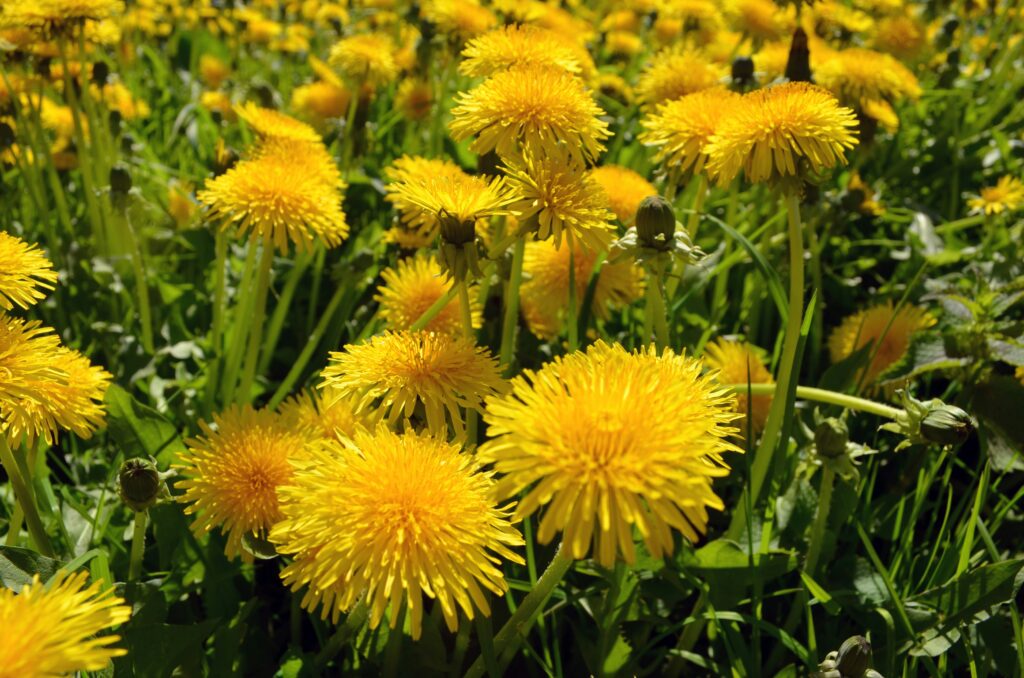By Jenna Outcalt, UConn Journalism
May 17, 2025

Growing up in a classic picket-fence suburb, I was no stranger to “lawn envy.” Neighbors and my own parents would nod in approval or shake their heads in disappointment, depending on how much grass was green versus brown, how many shrubs were overgrown and how many weeds choked out the grass.
But as kids, my neighbor Valerie and I didn’t see weeds as pests. We were making flower crowns as soon as we figured out how to, and we made salads we could never eat with dandelions, clover and onion grass. As young as we were, we certainly wanted to eat them, but every adult in the neighborhood would wave their arms and tell us we were about to ingest weedkillers.
Now that I’m older, I still think of our dandelion crowns and dandelion salads with affection, as fleeting as they were. And it makes me wonder why dandelions were looked down upon by the stewards of the suburban lawns I grew up around.
Although dandelions are not native to North America, they have been here since pilgrims came to the continent. Historians point to medicinal benefits as the most likely reason Europeans brought the flowers to the New World.
And dandelions really can be good for you. Botanists as long ago as the seventeenth century recorded that dandelions helped with digestion and urination. According to the National Library of Medicine, an herbalist in 1630 wrote, “Boiled, it strengthens the weake stomacke, and eaten raw it stops the bellie and helps the Dysentery.”
John Cardina, a professor of horticulture and crop science at Ohio State University, wrote about the history of dandelions in the United States in his 2021 book “Lives of Weeds: Opportunism, Resistance, Folly.” Cardina, who was not available for comment, explained in the book that dandelions were a popular plant in the 18th and 19th centuries.
“Americans prized it for its durability, relied on its persistence, and enjoyed its cheerful attractiveness,” Cardina wrote. “In return, dandelions were planted, cultivated, and nurtured. By the 1800s, it was a common crop in home gardens and fresh markets.”
However, dandelions aren’t just friends for humans. According to a 2024 enviroliteracy.org article, dandelions’ deep taproots improve soil health by breaking up compacted soil, preventing soil erosion while “mining” deep nutrients for other plants.
“They can pull minerals like calcium, potassium, and phosphorus from lower soil layers, effectively ‘mining’ these nutrients,” the article said. “When the dandelions die and decompose, these nutrients are released back into the upper soil layers, making them available to other plants.”
Although dandelions are not particularly powerful food for pollinators in their own right, they are important supplements in areas that are mostly paved or that have fewer native wildflowers, according to an article by Steph Sosinski, the home horticulture program manager at the University of New Hampshire.
So why do children now get scolded for making wishes on dandelions and scattering their seeds to the wind? The answer is simple: lawn culture has decided anything unintentional is unacceptable. Cardina explained that after the Civil War, attitudes about the flower began to change as lawns became a symbol of order and status.
“Over time, the notion of the idealized manicured lawn, mossy green, lush, short, and neatly edged like a crew-cut soldier standing at attention, led Americans to rethink their toleration of yellow-flowered interruptions,” Cardina wrote.
By 1945, herbicides originally intended for agricultural use were marketed to suburban families for the perfect lawn, according to Cardina. As “whole industries mobilized” to promote cookie-cutter yards, more and more products insisted upon suburban conformity.
“Inventions that had been developed for the farm were miniaturized for the suburban half acre of green. [Herbicides] that farmers sprayed to kill dandelions in corn fields were repackaged with macho names and jacked-up prices for sale across urban America,” Cardina wrote.
The advertising convinced homeowners that applying herbicides to their lawns was the right thing to do for the Earth. A 2003 study by Ohio State University showed that “lawn chemicals with potentially detrimental impacts on the ambient environment are understood as taking care of the environment.”
According to the study, suburban homeowners who attempt to resemble the picture-perfect lawns of chemical advertisements are more worried about the quality of the environment where they live and are more community oriented.
“Chemical users are more likely to be concerned about their neighbors’ values and feelings. They are more likely to get their lawn management information from family members,” the study said.
Through a desire to keep neighborhoods as idyllic as the ones in those advertising images, suburban homeowners came to despise the dandelion. After starting as a beloved medicine, food base and cheerful indication of springtime, the dandelion became an enemy of the American suburbs.
My mother was never opposed to dandelions as a plant, but she did like our lawn living up to her own vision. I was often enlisted to help get rid of the dandelions in our yard when I was young. However, instead of dumping chemicals on our lawn and razing the earth to get rid of the little flowers, we gingerly uprooted them and learned how to put them to work.
Think about making some dandelion wine for your next get-together with friends. Try brewing dandelion tea to boost your digestion. Throw dandelion greens in your next salad. Or just make a flower crown for your neighbor. Just as long as you remember what everyone seemed to know decades ago: these little yellow flowers have a lot to offer us this spring.
